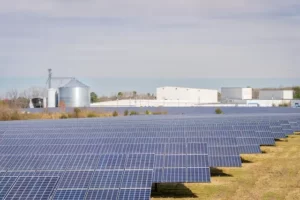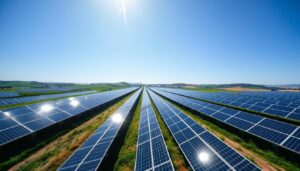
So, you’ve decided to harness the power of the sun and bring those savings right to your doorstep.
But now comes the real challenge – getting your solar system hooked up to the grid.
It’s like figuring out a complex puzzle, but fear not, because we’ve got your back.
In this 11-step guide, we’re going to walk you through the process of connecting your solar panels to the grid, ensuring that you not only save money but also make a positive impact on the environment.
But before we dive into the nitty-gritty details, let’s start with the basics, shall we?
Key Takeaways
- Understanding the basics of grid connectivity is essential for connecting a solar system to the grid.
- Evaluating your home for solar panel installation involves assessing the roof condition and shading impact.
- Selecting the right solar panels and inverter involves considering factors like efficiency, longevity, and compatibility.
- Navigating permits and regulations is crucial to ensure compliance and safety when connecting a solar system to the grid.
Understanding the Basics of Grid Connectivity
If you’re considering a grid-connected solar system for your home, it’s important to understand the basics of grid connectivity.
The grid connection process involves getting approval from the Distribution Network Service Provider (DNSP), which is essential for ensuring that your system meets safety and technical standards.
One of the key benefits of grid-connected systems is that they allow you to draw electricity from the grid when your solar panels aren’t generating enough power. This means you have a reliable source of electricity even when the sun isn’t shining brightly.
Additionally, when your solar panels produce excess electricity, it’s fed back into the mains grid, potentially earning you credits or even payments from your electricity provider.
To make this all work, your solar panels require grid-interactive inverters, which convert the DC current produced by the panels into the 230-volt AC current used in your home.
Understanding these basics will help you navigate the process of getting your grid-connected solar system up and running smoothly.
Evaluating Your Home for Solar Panel Installation
Assess your roof’s condition and potential shading issues before installing solar panels to ensure optimal efficiency and performance. Here’s how to evaluate your home for solar panel installation:
- Roof Condition Assessment: Check for any signs of damage, such as leaks, cracks, or missing shingles. Ensure that the roof is structurally sound and can support the weight of solar panels for at least 25 years.
- Shading Impact Evaluation: Identify any potential sources of shade that could affect solar panel efficiency, such as nearby trees, buildings, or other obstructions. Consider how the sun moves across your roof throughout the day to anticipate shading issues.
- Mitigate Shading: Explore options to minimize shading impact, such as strategically placing solar panels in unshaded areas or trimming trees that cast shadows on the roof during peak sunlight hours.
- Address Roof Repairs: If any roof repairs or replacements are needed, it’s essential to address them before installing solar panels to ensure a secure and durable foundation for the system.
Evaluating your roof and assessing potential shading issues is crucial in determining the feasibility of solar panel installation and maximizing the long-term benefits of solar energy for your home.
Selecting the Right Solar Panels and Inverter
When choosing the right solar panels and inverter for your home, it’s important to consider the type that best suits your needs and budget. You might’ve come across the terms monocrystalline and polycrystalline panels. So, which one is better?
Monocrystalline panels are known for their high efficiency and longevity. They’re a great choice if you have limited roof space and want to maximize the power output.
On the other hand, polycrystalline panels are more cost-effective and offer a good balance between performance and affordability. If you’re looking to stick to a budget and have ample roof space, polycrystalline panels might be the way to go.
Now, let’s talk about choosing the right inverter for your solar panel system. It’s crucial to match the inverter to your solar panels. For grid-connected systems, a grid-interactive inverter is a suitable choice. This type of inverter allows you to feed excess power back into the grid and also provides backup power during outages.
When selecting an inverter, consider factors such as efficiency, warranty, and compatibility with your solar panel system. By making informed choices about your solar panels and inverter, you can ensure optimal performance and savings for your home.
Navigating Permits and Regulations
Before you start installing solar panels, it’s essential to understand the local zoning laws and building codes that apply to your area. Navigating permit processes and regulations can be complex, but it’s a crucial step in ensuring that your solar panel installation is compliant and safe.
Here’s what you need to know:
- Obtain Necessary Permits: Research and obtain the required permits and approvals from your local authorities before beginning the installation. This may include building permits, electrical permits, and possibly special permits for solar installations.
- Comply with Regulations: Ensure that your solar system installation meets all safety and electrical standards. Additionally, be aware of any regulations related to grid connection and feed-in tariffs that may apply in your area.
- Consult with Professionals: Navigating the permit process can be daunting. Consider consulting with a professional who has experience in solar installations to assist you with the permit applications and ensure compliance with all regulations.
- Streamline the Process: Working with professionals can help streamline the permit process, saving you time and ensuring that everything is in order before you begin installing your solar panels.
Navigating permits and regulations may seem overwhelming, but with the right guidance, you can ensure that your solar panel installation meets all the requirements.
Establishing a Connection With Your Utility Company
Now that you’ve navigated the maze of permits and regulations, it’s time to explore how to establish a connection with your utility company for your grid-connected solar system. When it comes to negotiating fees with your utility company, it’s essential to understand the various charges associated with connecting your solar system to the grid. Some utility companies may have connection fees, demand charges, or other related costs.
It’s important to have a clear discussion with your utility company to ensure you’re aware of all the potential fees and to negotiate where possible.
In the process of establishing a connection with your utility company, troubleshooting the connection may be necessary. Sometimes, there can be technical issues or misunderstandings that need to be addressed. It’s crucial to maintain open communication with your utility company to resolve any connection problems efficiently. This may involve coordinating with your solar installer to ensure that all components are properly connected and functioning as intended.
Frequently Asked Questions
How Much Does a 10kW Off-Grid Solar System Cost?
Hey, if you’re considering off-grid options, a 10kW system can cost between $20,000 to $40,000. Solar financing and government incentives might help offset some of the upfront expenses.
How Do I Connect My Solar Panels to the Grid?
First, ensure your solar installation is approved by the DNSP. Then, connect grid-interactive inverters and a bi-directional meter to your solar panels. This allows excess energy to flow into the grid, reducing your electricity costs.
Do I Have to Connect My Solar to the Grid?
You don’t have to connect your solar to the grid, but it’s a good idea to consider grid independence. Solar battery storage lets you store excess energy for later use, providing backup power and potential cost savings.
Who Has the Best Solar Feed-In Tariff in Victoria?
You should compare tariffs from different solar providers in Victoria to find the best feed-in tariff. Consider factors like solar panel efficiency and maintenance costs to maximize your earnings. Don’t rush, take your time comparing options.
Conclusion
So, there you have it! With this guide, you’re well on your way to connecting your solar system to the grid. By following these 11 steps, you can start reaping the benefits of solar savings and do your part for the environment.
It may seem like a lot to tackle, but trust us, it’s worth it in the end. Get ready to enjoy the perks of clean, renewable energy while saving money on your utility bills!



